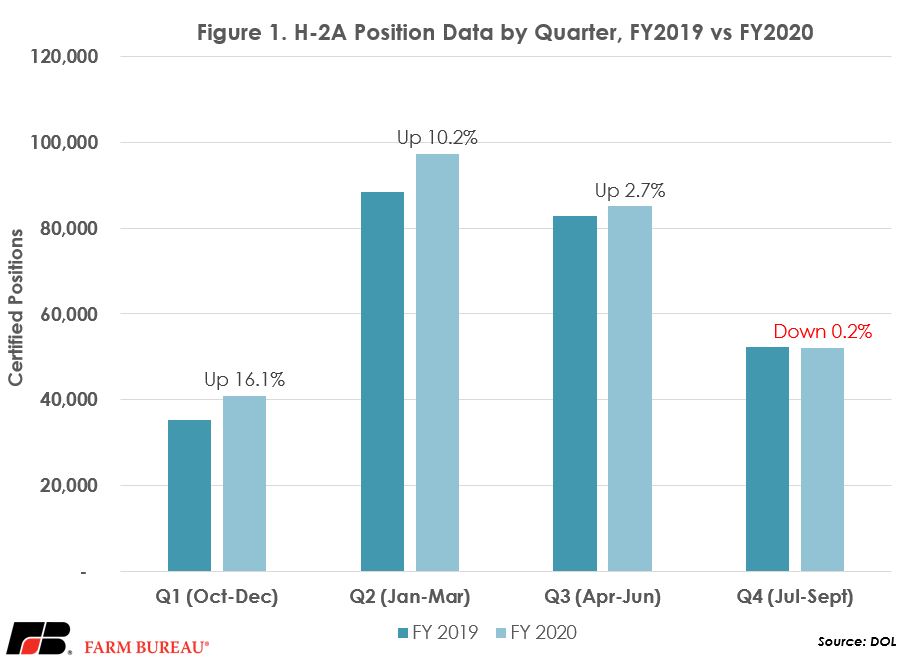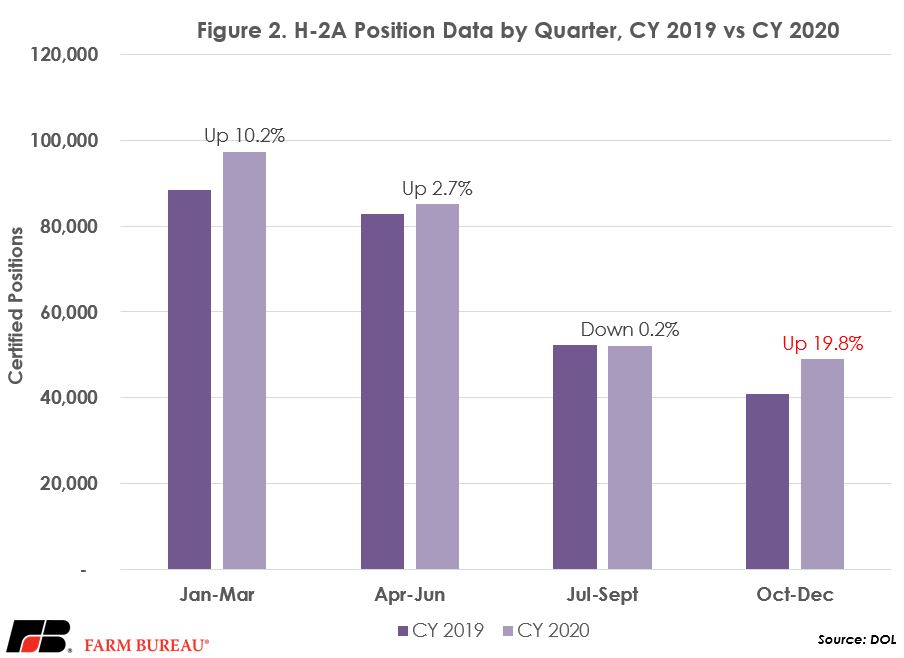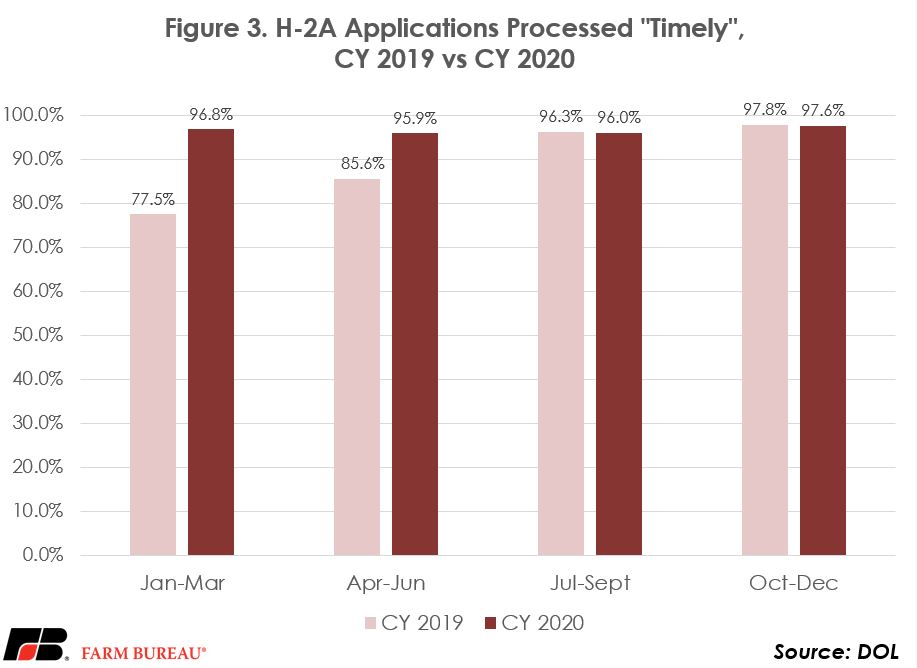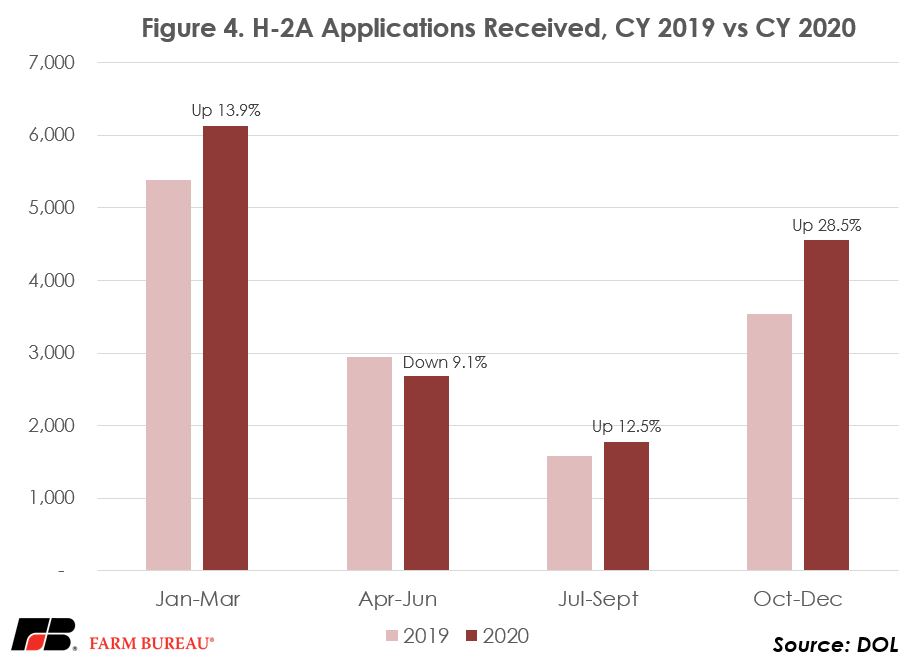Recently released H-2A program data reveals some interesting impacts of the global COVID-19 pandemic. For the first time since the Department of Labor began reporting quarterly data in 2013, the number of certified positions declined in the fourth quarter (July 1 – Sept. 30) of fiscal year 2020. However, the number of certified positions in the first quarter of fiscal year 2020 (Oct. 1 – Dec. 31) climbed by nearly 20 percent, suggesting that while the pandemic has shifted the pattern of worker arrivals, it has not suppressed the overall upward trajectory of the program.
Generally, the H-2A program is discussed on a fiscal year basis (October – September). However, we can all agree that calendar year 2020 was a beast all its own, giving us a reason to look at H-2A data through a calendar year lens. We’ll start by looking at the fiscal year though, given that it is the primary basis for comparison.
Fiscal Year Basis
Overall, usage of the program in fiscal year 2020 (Oct. 1, 2019 – Sept. 30, 2020) continued its steady upward march. More than 275,000 H-2A positions were certified in fiscal year 2020, up 6.5 percent from fiscal year 2019. This was the eighth consecutive year that usage of the H-2A program set a record. As shown in Figure 1, program growth in fiscal year 2020 started off strong and then petered out as the year -- and the COVID-19 pandemic -- wore on.

Calendar Year Basis
When the data provided by DOL is transformed from a fiscal year basis to a calendar year basis, the impact of the global COVID-19 pandemic becomes more pronounced. As shown in Figure 2, the slight 0.02 percent decline in certified positions from July-September 2020, as compared to the same months in 2019, is followed by 19.8 percent jump in certified positions from October-December, as compared to the same months in 2019. The same pattern is observed in the number of submitted applications, as shown in Figure 3. A decline in submitted applications of 9.1 percent in April-June 2020, compared to the same months in 2019 was followed by a sizable increase of 12.5 percent in July-September 2020, compared to the same months in 2019.


Keen observers of the H-2A program will immediately wonder if the slowed growth in H-2A positions was related to slow application approval. According to the same DOL data, this does not appear to be the case. Over the course of calendar year 2020, the share of applications processed in a timely manner averaged 96.6% and, as shown in Figure 4, there was little variation across quarters, less than in 2019, in fact.

Takeaways
When Figures 3 and 4 are considered together, there are two main takeaways from the data. First, it seems that the initial impact of the COVID-19 pandemic was a decline in the number of applications and subsequently the number of certified positions in the following quarter. Second, that initial decline was not the result of lack of demand, but rather uneasiness about how the H-2A program would operate as a result of COVID-19. We all remember the early months of the outbreak, when the U.S. State Department suspended routine immigrant and nonimmigrant visa processing in Mexico in mid-March 2020. After farmers shared their concerns that the restrictions would lead to a farm worker shortage in the U.S., the restrictions on the processing of visa applications submitted by farm workers in Mexico were quickly revised, yet challenges remained, particularly those related to transportation and ensuring worker safety when PPE was so difficult to obtain. Once the situation started to become clearer, applications from July-September rebounded by 12.5 percent and led to a nearly 20 percent increase in certified positions from October-December. Given the whopping 28.5 percent increase in the number of applications received from October to December 2020, we should expect to see a record number of certified positions from January to March 2021.
New Travel Restrictions
On Jan. 26, travel restrictions to combat coronavirus infections went into effect for several countries. For some countries this was a reinstatement of previous restrictions, for others the restrictions were new. The restrictions apply to non-U.S. citizens who have been in Brazil, China, Iran, the Republic of Ireland, South Africa, the United Kingdom and the Schengen Area of Europe (Austria, Belgium, Czech Republic, Denmark, Estonia, Finland, France, Germany, Greece, Hungary, Iceland, Italy, Latvia, Liechtenstein, Lithuania, Luxembourg, Malta, Netherlands, Norway, Poland, Portugal, Slovakia, Slovenia, Spain, Sweden, and Switzerland).
These restrictions immediately became a concern for H-2A program users, especially those who hire approximately 5,000 of these valued essential workers from South Africa, 90 from the Schengen Area, 40 from Brazil and 90 H-2A each from the United Kingdom and the Republic of Ireland. After outreach by the agricultural community, the State Department quickly clarified on Jan. 28 that agriculture workers from South Africa entering the U.S. qualify for national interest exceptions on a case-by-case basis. Restrictions on H-2A workers from the other countries remain in place.
Summary
Despite the challenges the pandemic has brought to farmers who rely on skilled workers from other countries, H-2A program demand continues to grow.